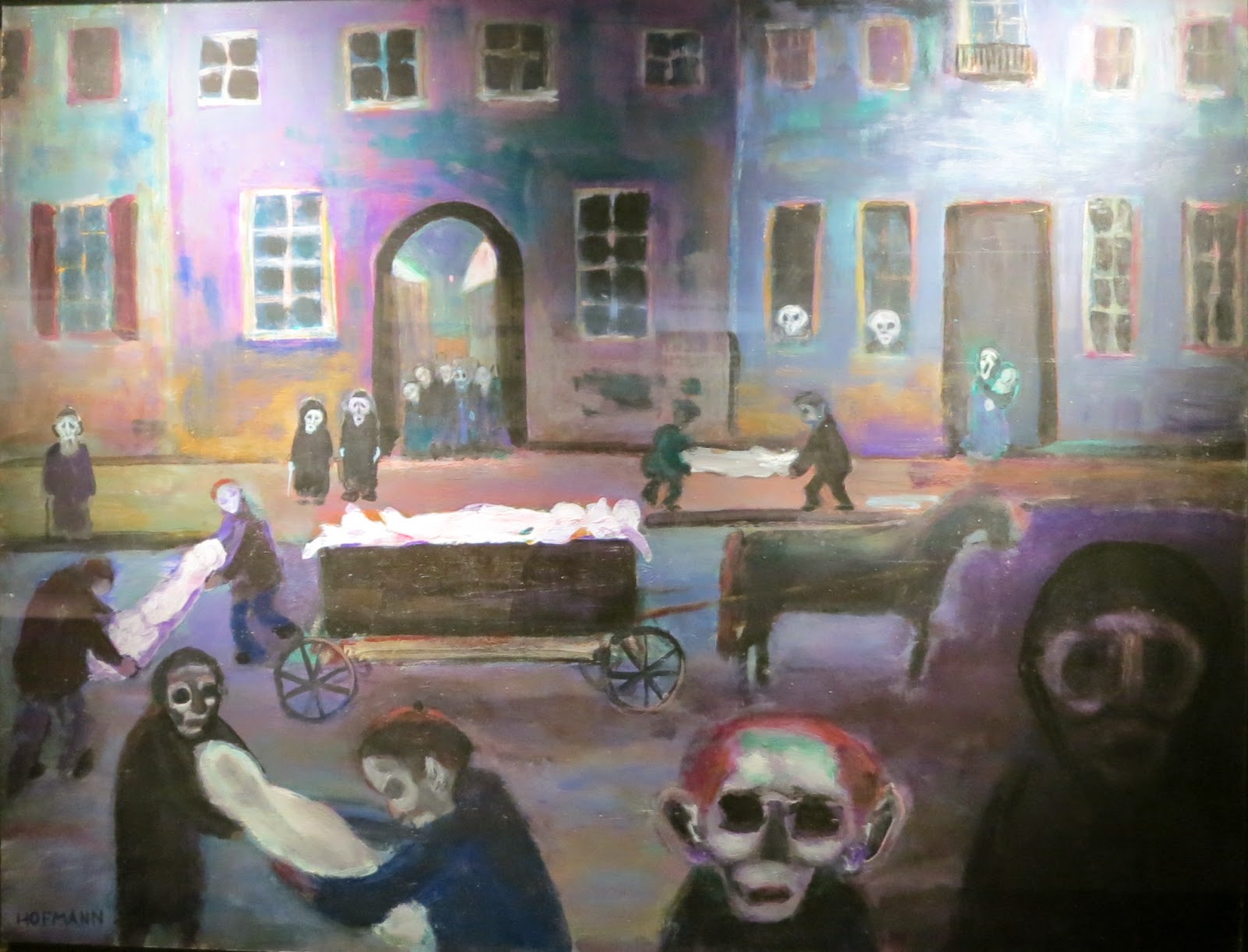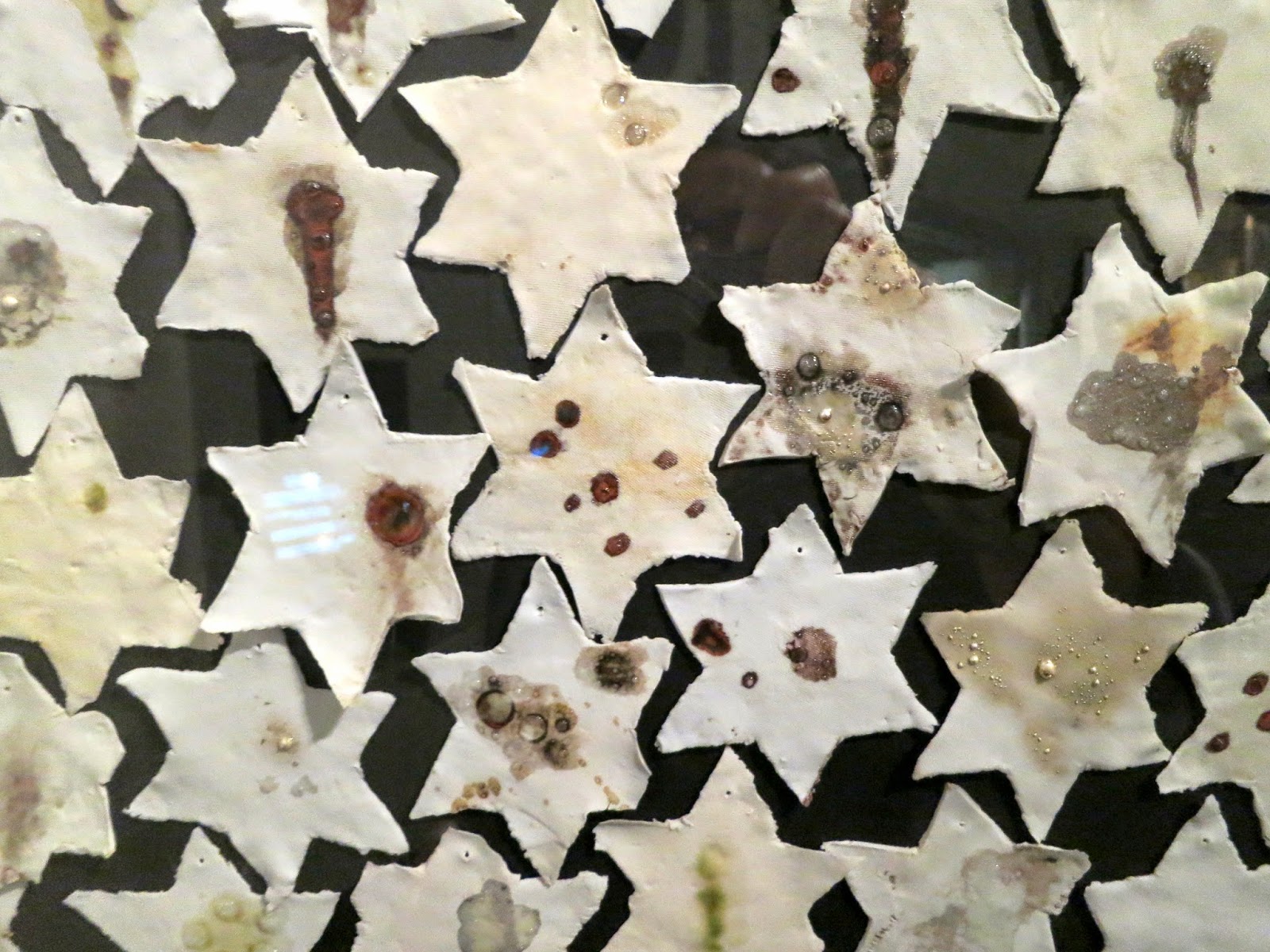Imperial War Museum, Manchester, designed by Daniel Libeskind - the interior.
My interest lay with the building, but while we walked around, I was very pleasantly surprised by the way the exhibition was curated. Rather than being all about warfare, there was emphasis on the effects of war and opposition to it. What is included in this post is very selective - it's a pacifist's choide of what was exhibited. But, first about the building:
Entry to the museum is through the Air Shard (for more information on this, the exterior and the concept behind the museum, go here ).
On the wall by the entry is Libeskind's architect's statement: 'I wanted to create a building that people will find interesting and wish to visit, yet reflects the serious nature of a war museum. I have imagined the globe broken into fragments and taken the pieces to form a building; three shards that together represent conflict on land, in the air and on the water'.

The design of the concept is depicted in the entrance, but I could not get a good enough photograph so I have included this image which is in the foyer instead.

Like Libeskind's Jewish Museums, this is a building that disturbs and disorients, encouraging you to reflect on the perils, the mechanics and above all, the human cost of war. The slanting walls, the aggressively acute, almost jagged angles serve as reminders of senseless destruction. This is an abandonment of traditional architecture practice, an embracing of architecture as fragmentation, de-centredness and loss that reflects the reality of what war does to humanity.
Still in the entrance, the aluminium walls shine and reflect.
To the right of the entrance is the large foyer that directs you to the Earth Shard via the stairs or a lift.
The stairs leading up to the main gallery space
The upstairs landing with stairs and lift
The lift. The frames of doorways and windows, as well as the opening on the towering Air Shard, are accentuated in striking red - association with the blood spilled in battle and the poppy.
Looking up

The cavernous principal gallery is housed under a massive roof that follows the curvature of the earth. Freestanding, slanted walls divide this space and give it drama.
Gerry Judah, The Crusader, 2010
The sculpture is covered by a network of war-damaged buildings, water towers, communication wires and satellite dishes. 'The Crusader combines the contradictions that preoccupy me as an artist. It explores the violence of conflict against a perceived righteousness of purpose. The beauty of the sculpture contrasts with the darkness of the subject matter'.
An ex-US Marines' AV8a Harrier jump-jet dominates the space by the entrance
The suitcases of the dispossessed line the walls of one of the sub-sections of the vast space - unfortunately I did not get the name of the artist
looking closer
'People think they were fighting for something that's going to be uplifting and it's going to make everything better. It doesn't. War never makes anything better', reads one of the labels. And another: 'I used to have these blooming nightmares, and it was the war every time... I had those for quite a time....
Steel window section from the ruins of the World Trade Center
Child's Play comments on the parallel worlds of innocence and violence which dwell in the human psyche. Most of the displayed objects are children's toys used to 'play at war', from weapons and soldiers to sticks and stones. The objects are wrapped in cloth as a ritual gesture to express the often conflicting desire to both remember and separate from the past.
looking closer
This is an expressive space that makes itself felt: sloping floors, slanting walls, sharply-cut lines of light on the ceiling. The displays are part of the architectural experience and vice versa.
Concealed projectors transform the gallery into, for example, a 360-field of towering red poppies, or bring the walls alive with images, still or moving, of any aspect of war.
The story of Edith Cavell, a WWI nurse who helped over 200 allied troops to safety. She was shot at dawn on 12 October 1915, accused of helping British and allied troops to escape the German front line.
A section on women and war
The fight against fascism
Edith Birkin, The Death Cart, 1980-83
Edith Birkin and her family were sent from Prague to the Lodz ghetto in 1941. Her parents died in the ghetto within a year of their arrival. In 1944 she was sent to Auschwitz and then to a labour camp. In March 1945 she was sent to Bergen-Belsen and was liberated a month later. She returned to Prague and later settled in Britain.
'I evolved a pictorial language, that enabled me to put my visions on canvas... I wanted to show what it felt like to be a human being in a starved, emaciated, strange-looking body, forever being separated from loved ones'.
Chava Rosenzweig, A Star shall Stride from Jacob and a Sceptre Bearer shall Rise, 2013 (ceramic)
looking closer
a vitrine with various relics from the Holocaust
looking closer
Violette Rougier Lecoq, Ravensbruck Concentration Camp, 1946
Lecoq was a nurse working for the French Red Cross at the outbreak of WWII. She later joined the French Resistance, organising the escape of prisoners from a military hospital. In 1942 her network was discovered, she was captured and sent to Ravensbruck concentration camp.The sketches she made there were later used by the British Military Tribunal at Hamburg as evidence of the atrocities suffered by the prisoners.
the Atom Bomb
and a copy of Raymond Brigg's When the Wind Blows - that brought memories back: I had a copy in my classroom library
I took this photograph because at that spot I was very aware of the disorientation brought on by the sloping floor. Unfortunately this does not come across in the photograph

'We knew about the trouble in Ireland very soon as the German had it up on a board in front of our trenches... On the same day as the fighting in Dublin the Germans made an attack on the Irish Fusiliers... the next day the Germans sent over gas and wiped out a whole battalion....'
Designed to spread fear and confusion, this German trench sign warned Irish solders of the Easter Rising in April 1916.
John Keane, Peace Giant, 1990
This lithograph shows British Army observations towers in County Armagh, on the border between Northern Ireland and the Republic of Ireland. These camouflaged towers were placed at strategic points to allow British soldiers to monitor areas of violence. The towers were taken down by the British army as part of the peace process.
This painting shows a corrugated iron fence used to separate sectarian areas of Belfast in Northern Ireland. Despite the iron divide, life appears to go on as normal.
A second, small gallery had an installation of a northern village during war time, complete with shops, and vintage clothing that the kids could dress up in. It was not possible to stay in there for very long: the kids were very excited and very noisy, and the contrast with the other gallery was a bit too much. Bless!










































No comments:
Post a Comment